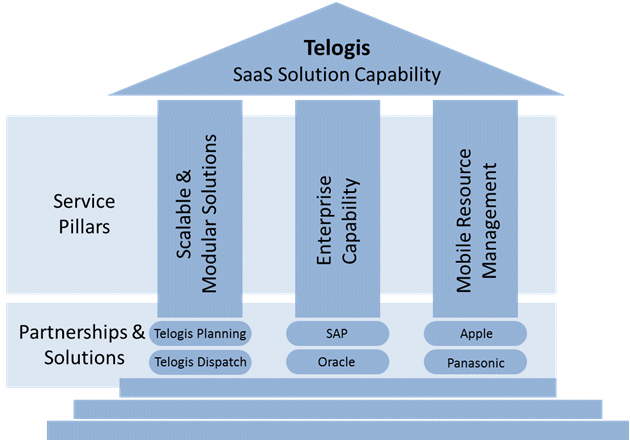The North American commercial vehicle telematics market is piped for exponential growth with the electronic logging device (ELD) mandate and the realization of the latent productivity improvements of telematics solutions; the region offers immense potential opportunities for growth to market participants. Verizon has been leading the market with about 25%-27% market share as part of the consolidation of its 3 wings in the telematics segment, NetworkFleet, Telogis, and Fleetmatics. Here, we discuss the case of Telogis, a company that has adopted a service delivery model that assures customers of consistent product development, in order to maximize stakeholder value. It had embraced the software-as-a-service (SaaS) business model early on and has developed a diverse portfolio by understanding the customer’s need for a modular telematics solution.
Telogis has built a connected vehicle environment despite mounting industry challenges. Its advanced fleet management capabilities have allowed fleet management companies around the globe to successfully track their fleets by leveraging cloud-based vehicle information from any remote location without having to maintain their own individual servers. Telogis has thereby minimized its end users’ cost of ownership by reducing capital investments and eliminating additional internal information technology (IT) staff for on-site / premise-based technology management.
Despite these obvious advantages, what endears a prospective customer to the services offered by Verizon’s Telogis is the wide array of customizable resource management both for the mobile workforce and vehicular assets. Leveraging its ability to co-exist with its competitors without adopting an inorganic approach, Telogis has successfully registered strong growth rates every year. The array of services introduced by the company to optimize end-user costs and improve driver safety offers attractive performance incentives to customers, displaying the company’s ability to implement best practices in telematics even amidst stiff competition. The company offers distinct modules for telematics, planning, mobile resource management, dynamic routing and scheduling, enterprise integration, and web-based location services.
The Telogis Route Planning Suite (introduced on September 30, 2013) in particular, enables its customers to be more responsive towards fleet planning and ensuring effective management of last-minute orders such that customer satisfaction is maximized. Another of its many products is the Telogis Dynamic Response Suite, which was launched on October 29, 2014. This is a comprehensive SaaS platform that ensures 360-degree job visibility, delivers better customer service, and facilitates continuous workflow improvement. By developing such value-driven services and products on a continuous basis, the company has strengthened its competitive position in the North American market, clearly establishing its leadership abilities over competitors. Devising strategies for the benefit of customers through in-cab alerts, driver scorecards, fuel management facilities, and driver dashboards has been Telogis’ core approach to surviving amidst competition. Apart from improving the functionalities of its current high-quality offerings (accredited with the ISO 9001:2008 certification) and upgrading them as per the changing market dynamics, Telogis has essentially created an enriched ownership experience for its customers by engaging end users at every step of the service delivery chain. The focused approach of the company to reach out to a broader audience by addressing their pain points has helped it penetrate deeper into the market.
Telogis’ mobile and integration solutions, being SaaS solutions, can address unique client requirements through an application programming interface (API) for integration with enterprise resource planning (ERP), payroll, asset management, and mobile resource management services. The alliance between Telogis and Apple, inked on October 27, 2015, is a prime example of a Telogis mobile asset management (MAM) solution that is directed towards connecting customers’ vehicles, equipment, and people. For instance, the Telogis Navigation application provides pertinent truck-specific instructions to help drivers ride safely and stay abreast of surrounding situations, thus leading to overall job satisfaction. Telogis also offers mobile resource management solutions in wearables to address the ‘lone worker’ laws that require checking up on employees.
Fig 1: Telogis’ flexible solution advantages of SaaS model

Noted partnerships with Ford, GM, Volvo, Mack, Hino, and Isuzu that Telogis has entered into globally have expanded with passing years, which automatically augments the brand image and instills a sense of pride among customers. Additionally, staying abreast of customer concerns and resolving them promptly drives the company towards success, over and above its commitment to addressing changing user needs. Telogis has been successful in delivering its customers with round-the-clock support services and user-specific training modules. Each of its 90-minute training sessions is focused on educating customers about the Telogis product portfolio. These modules help the driver to not lose the driving track, enable a dispatcher to send a driver to the closest destination, assists in developing a most suitable vehicle technician, and trains a fleet manager to perfectly plan the travel and easily execute the associated processes. This makes up for the lack of onsite personnel while also providing the end customer direct control over their productivity tools.
The company’s strong technological capabilities and proper understanding of customer needs have enabled it to carve out a niche for itself in the North American market. Telogis has undoubtedly redefined the North American fleet management landscape with its advanced SaaS technology platform. However, it is not alone; several of the leading telematics service providers (TSPs) around the world have adopted similar strategies by adopting a SaaS type of service model. In conclusion, SaaS solutions for TSPs have been successful only when the company deploying the service reorganizes itself to cater to latent customer needs, such as mobile resource management, dispatch and delivery services, and necessary training of personnel. It is also relevant to note that the services are almost always modular, customizable, and can be integrated seamlessly with existing businesses.



